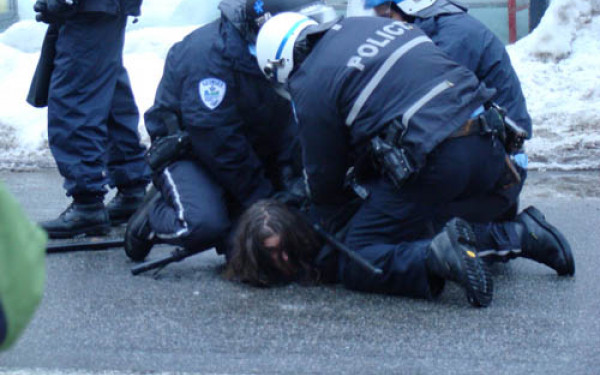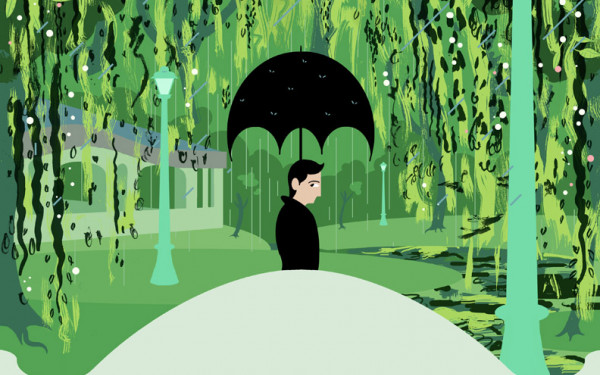Hi, Rollers
Bones Break and Teams Grow in Montreal’s Derby League
The girl in the gold booty-shorts means business.
She knocks down the other team’s small, point-making jammer, who goes by the name “Saucisse.” The jammer smacks into the middle of an eight-skater clump—careful to keep her fingers tucked in as the pack passes over and around her.
“Body checking is legal,” said Smack Daddy—aka Val Desjardins—the head of the Montreal Roller Derby training committee.
“But on the body there are legal zones. […] You can hit people on the sides, on the chest, and on the hips. The point is, you’re trying to move them either outside of the track or within the track. Move them over so your jammer can go by and score points.”
The jammers are small and fast. They need to be, to weave through the pack and earn points for their team. Every time the jammer passes a member of the opposing team, her team earns a point.
“When you’re in the pack, there’s a lot of stuff going on,” Smack Daddy said. “People falling and you have to jump over them—there’s a lot of little injuries that can happen. […] Normally at the end of the season you have three or four injured players.”
Smack Daddy herself has been sidelined by a spiral fracture that took 13 screws in her leg to set. She’s not sure she’ll rejoin Montreal’s all-star international team, The New Skids on the Block, in time for the World Cup. Until then, she’s busy coaching the purple and gold-wearing local team that loves to be hated, Les Filles du Roi.
The Montreal Roller Derby League has been around since 2006, but already a lot has changed. It’s gone from a bunch of rockabilly girls doing shots of whiskey between periods to an established league that trains recruits in injury prevention and body-strengthening, depending on their position.
“Because of the history of roller derby, a lot of the culture was drinking Pabst Blue Ribbon and slanted towards entertainment, outfits, [and] girls in skirts,” said Smack Daddy.
“And that’s just being phased out. Most people used to wear fishnet tights and booty shorts, whereas now most people are wearing compression shorts. […] We’re real athletes now.”
From the bleachers at Aréna St-Louis, the game looks like ten girls in old school roller skates going around in a big circle, with a lot of pushing, falling and jersey-grabbing going on. The music playing between the whistles is as diverse as the crowd—Britney Spears songs mixed in with new wave hits, and punk.
03_900_598_90.jpg)
The jammers are easy to spot because they’re whizzing around the area with stars on their helmets. They’re trying to pass “the pack”—the eight girls whose job it is to block or help them, depending on their team. The pack is made up of “blockers.” The jammers are bumped around like human soccer balls when they try to get through.
“Punching someone in the face—that kind of of old-school, ‘70s WWF shit—doesn’t happen anymore,” Smack Daddy said.
Roller derby has its roots in the cheap, Depression-era entertainment of the 1930s. Marathon dance nights could go on for days and promised prizes to the last couples standing, and marathon skating had its place too.
Men and women would skate around a banked oval track thousands of times. The creator of Roller Derby, Leo Seltzer, noticed that the crowd was particularly into it when skating-induced exhaustion led to crashes and falls. So he came up with a sport that showcased those crowd-pleasing slapstick-like moments.
Roller derby has changed with the decades. In the 1930s, it was called the first sport where women played by the same rules as men. As it evolved, the aggressiveness was turned up. By the 1960s and ‘70s, it was a choreographed spectacle. There were the good guys, the bad guys and the staged fights. By the mid-‘70s, the roller derby league had fizzled out.
Any team playing in North America today has Texas to thank for the sport’s modern revival in 2001 after leagues like Austin’s TXRD Lonestar Rollergirls sprang up. A few years later, Canada got in on the act, as 2006 saw leagues appear in Toronto, Vancouver and Hamilton as well as Montreal.
“A lot of the culture was drinking Pabst Blue Ribbon and slanted towards entertainment, outfits, and girls in skirts. And that’s just being phased out. Most people used to wear fishnet tights and booty shorts, whereas now most people are wearing compression shorts. We’re real athletes now.” – Smack Daddy, Montreal Roller Derby training committee head
But times had changed. The players’ tendencies to model themselves after the sexy roller-girl image and old-school showboating antics began to conflict with emerging attitudes towards real sportsmanship. It took some time for the league to figure out what exactly it wanted to be.
“After every practice, people were going out for beers,” Smack Daddy said of the Montreal league’s inception. “It was part of this rockabilly, marginal bunch of rag-tag party girls who wanted to play a sport together. Now it’s become much more serious.”
She added that a lot of the media coverage roller derby attracts focuses on the lifestyle associated with it rather than the sport itself.
But considering how much the league has grown and changed in just a few years, it has taken the general public some time to catch up. The idea that it’s a show featuring party girls being aggressive and sexy has remained popular in the mainstream.
“We’re playing a sport in which we’re wearing tights, we’re hitting each other, we’re being somewhat violent and intense, and then we all walk away hugging each other and have an after-party.
“There’s this sisterhood that people still have [problems with]; they just want to sexualize it. They’re like, ‘Awesome, girls hitting each other and wearing tights—it’s sexual.’”
Adding weight to the serious sport argument is the number of professional athletes and Olympians in U.S. roller derby leagues.
“These girls are generally much bigger than us. We’re like these scrawny little Canadians from the Mile End. These girls from Nashville—their thighs are like the size of our waists. We’re tiny.”
As a not-for-profit, the players are also the league’s volunteers. They coordinate even the mundane aspects of keeping the games rolling. But as the league grew, they needed a place for meetings and a place to party after games, so they opened the Royal Phoenix Bar as their official hangout. Smack Daddy is the owner.
“We opened it with the mentality of roller derby—our people having a clubhouse and a spot to hang out and a bar to have parties. Our crowds reflect what the derby community reflects. Like, super mixed and eclectic, but also very aware that it’s a queer space and that diversity is number one.”
At the corner of Bernard Ave. and St. Laurent Blvd. in the Mile End, the Royal Phoenix is just a block away from Aréna St-Louis. It hosts the league’s after-parties, and half the staff is roller derby girls.
The home season ends in August with boot camp for newbie players starting right afterwards, and running until October. There are two more game nights scheduled in Montreal this season.
On July 21, the quirky and eccentric La Racaille play the rockbilly troublemakers Les Contrabanditas and The New Skids on the Block are also playing against New Hampshire’s Free Skate or Die! All Stars the same night.
The championship match, to cap the season for the local teams, will be Aug. 4.

_900_600_90.jpg)
02_900_598_90.jpg)
01_900_598_90.jpg)
_600_832_s.png)

2_600_375_90_s_c1.jpg)
1_600_375_90_s_c1.jpg)

